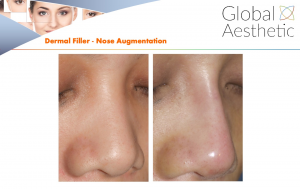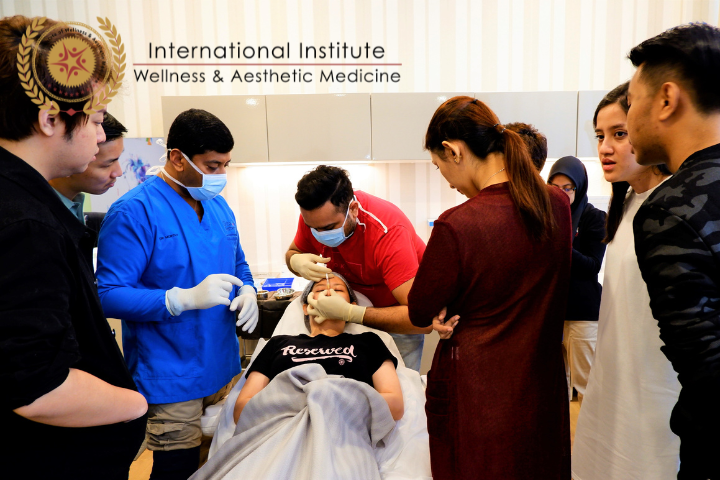Do’s and Don’ts About Nose Augmentation
A perfect nose balances the facial features and improves the overall natural beauty of the face. Nose augmentation also known as rhinoplasty is an aesthetic procedure that helps to reconstruct and improve the overall appearance of the nose.
At Aesthetic Academy Asia, we have a team of Certified doctors that impart comprehensive clinical knowledge and hands-on-training to doctors, dentists, Aesthetic Nurses, Aestheticians, and spa owners in the field of Aesthetic medicine. Aesthetic Academy Asia is based in Malaysia and receives Aesthetic students from the Philippines, Myanmar, Cambodia, India, Indonesia, and other parts of Asia. Assoc. Prof Dr. Morthy is the lead trainer and course director for the region. He is also the medical director of Global Aesthetic (www.globalAesthetic.com) which offers advanced Aesthetic medical procedures. Aesthetic Academy Asia with the insignia of “Be Certified, Be Recognized” has always stressed the importance of structured Aesthetic medical education with international recognition for those opting for a career in Aesthetic Medicine.
Under our European certification programme in Aesthetic Medicine and our International Online Aesthetic courses, Aesthetic students are trained extensively on the lip filler procedures to provide safe, effective, and perfect results. When administered by a knowledgeable individual with proper training, the risks of nose augmentation procedure can be minimized while maximizing the benefits, which is what Aesthetic Academy Asia aims at.
In today’s article, we will broach the subject of nose augmentation, the various types of advanced nose augmentation procedures available, do’s and don’ts about nose augmentation along the importance of training in nose augmentation procedures.
What is nose augmentation?
The nose can be considered as one of the most prominent central features of the face. Nose augmentation refers to an aesthetic procedure in which the structure of the nose is changed by adding or removing bone or cartilage, grafting tissue from another part of the body, or implanting synthetic material to alter the shape (and function) of the nose. The main aim of nose augmentation is to shape a misshapen nose for better aesthetic appeal. Apart from that, nose augmentation can also improve nasal functioning. It can correct breathing problems and birth-related defects in the nose.
How is nose augmentation performed?
The overall procedure of nose augmentation involves changing the angulation of the nose, altering indentations, reshaping the tip, or correcting bumps. A nasal splint is placed after the procedure to assist healing. Doctors with proper medical training make an incision across the columella tissue separating the nostrils. Soft tissues covering the nose are raised through these incisions, giving the surgeon access to conduct the reshaping procedure. After the underlying nose structure is transformed into the shape that is desired, the skin and tissues go back, and the incisions are closed. Nose augmentation procedures tend to enlarge or reduce nasal structures using cartilage that may be grafted from other parts of the body. A bone graft is an additional bone that is added to the bone in the nose usually from the septum or in some cases ear cartilage may also be used.

What are the main types of nose augmentation procedures?
There are mainly three different types of nose augmentation procedures which are also known as rhinoplasty. They are as follows-
Closed Rhinoplasty
Closed rhinoplasty can be considered as one of the most common types of rhinoplasty that are chosen by the patients. There are no external scars, as all incisions are done inside the nose. The soft tissues are lifted slightly upward, allowing access to the bone and cartilage for the doctors to make necessary changes through the small incisions in the nostrils. The incision is then stitched back, leaving only a scar in the nostril that is not visible from the outside. Closed rhinoplasty involves reduced nasal tissue irritation, less detectable scarring, shorter operating times, and faster recovery.
Open Rhinoplasty
Open rhinoplasty is considered as the favorable rhinoplasty procedure for patients who need extensive work done to the nose. The doctors will make incisions in the skin between your nostrils underneath your nose. This area is called the columella. Next, the skin is lifted to reveal the inside of the nasal cavity, giving the doctor access to perform the necessary reshaping. After the cosmetic medical procedure is complete, the columella is sutured and the nose will be secured in place with tape and a splint to keep the nose in place. The splint will keep the nose in place during the healing process and normally will be removed after one week. Open rhinoplasty is excellent for patients with issues such as genetic or structural deformities, trauma to the nose requiring grafting.
Filler Rhinoplasty
Given the advent of various injectable fillers along with their reported safety and efficacy, nonsurgical rhinoplasty has recently gained popularity for patients looking to alter the shape and/or appearance of the nose without incurring the risk, and downtime typically associated with the other rhinoplasty procedures. Filler rhinoplasty is almost painless, takes about 10 minutes, and lasts for years. No incisions are made, but rather, the injectable filler is used to correct minor imperfections in the nose. Without a doubt, the safest fillers to use are those that are not only biodegradable but also reversible, such as the widely preferred hyaluronic acid (HA) fillers, which can easily and rapidly dissolve with hyaluronidase. Not only does this reversibility provide some level of increased safety given the potential for vascular occlusion events, but also reversible products can be dissolved if overfilling or misplaced injections occur.
Alternatively, threads can also be used to reshape the nose. The selection between thread, fillers, or both will depend on the type of noise that you wish to achieve. At Aesthetic Academy Asia, our world-class trainers will provide detailed theory lectures and clinical training on both filler and thread as part of our advanced nose augmentation training courses.

(Source)
What are the do’s and don’ts you need to know?
Do’s:
-
The patient should give himself/herself a good cushion of time away from work or school in order to recover. However, they should be able to return to normal activities within 3 weeks.
-
The patient should keep his/her head elevated as much as possible after the cosmetic medical procedure. Sleeping with 2 pillows at night is highly recommended as the elevation of the head will help bring down the swelling.
-
The patient should take any pain medication and antihistamine as prescribed by the doctor. However, it is recommended to try to switch from pain meds to Tylenol as soon as possible as they can cause constipation.
-
The patient should follow his/her doctor`s directive to stop taking aspirin, Advil, or other similar medication for at least two weeks before and after the cosmetic medical procedure. Discontinuing the use of these medications or any medication that can thin the blood is imperative and can prevent excessive bleeding.
-
The patient should make sure that the wounds are kept dry, as getting the nose wet could prolong the overall recovery period.
Don’ts:
-
The patient is advised to avoid any kind of heavy exercise like lifting any heavy objects or activities like heavy housework that would overexert the body. Any activity that has the word ‘heavy’ attached to it is strictly forbidden immediately after the cosmetic medical procedure.
-
The patient is advised to not put anything in the nose. A saltwater nasal spray can help prevent crusting after the cosmetic medical procedure.
-
The patient is advised to not blow their nose or sneeze for a couple of weeks. If they have to sneeze, expel the sneeze through the mouth, not the nose.
-
The patient is advised to avoid crowded places as an inadvertent bump to the nose can move the nasal bone out of place and may require a revision rhinoplasty.
Why is training important?
Nose augmentation procedures should be performed by certified aesthetic practitioners who are trained individuals skilled to perform procedures with adequate knowledge about the treatment. This is crucial because a poorly performed nose augmentation procedure can cause infection, poor wound healing or scarring, change in skin sensation (numbness or pain), difficulty breathing, skin discoloration, and swelling.
At Aesthetic Academy Asia, the aesthetic doctors & aesthetic dentists are intensively trained in theory as well as clinical skills under our advanced aesthetic medical training for nose augmentation so that they can execute the cosmetic procedure, safely and effectively.
Similarly, Aesthetic nurses, aestheticians, and spa owners are also trained to understand the basic principles of nose augmentation procedure under our cosmetology certification programme.
The advanced aesthetic medical training for nose augmentation curriculum include:
-
What are the suitable nose augmentation procedures and why?
-
What are the principles of nose augmentation?
-
What type of fillers can be used?
-
What are nose augmentation-related complications?
-
How to avoid nose augmentation-related complications?
-
How to treat nose augmentation-related complications?
At Aesthetic Academy Asia, our cosmetology certification programme will coach you on the nose, lip, chin, midface, and infraorbital augmentation.

Aesthetic education at Aesthetic Academy Asia
At renowned Aesthetic Academy Asia, may it be for students from the Philippines, Myanmar, India, Cambodia, Indonesia, or any part of the world, we take Aesthetic education with utmost seriousness and help our students learn and practice effective Aesthetic procedures so they are confident enough to start their career in Aesthetic. Our students are well versed to handle any situation, simply because we focus on teaching the fundamentals and principles of the Aesthetic procedures before venturing into clinical skills. Our students learn advanced and new skills and techniques that are different than the textbooks. We teach them safe, effective, and affordable ways to perform Aesthetic procedures. In addition to the Professional Diploma in Aesthetic Medicine for Doctors & Dentists and Professional Certificate in Advanced Aesthetic for Nurses, Aestheticians and Spa Owners, Aesthetic Academy Asia also conducts specialized and advanced training such As Non-Surgical Body Sculpting, Dermal Filler (Restylane, Juvederm, Teosyal, Bellotero), Botulinum Toxin (Botox, Dysport, Xeomin), Skin Boosters (Restylane Skin Booster, Profhilo, Rejuran) Platelet Rich Plasma (PRP), Threadlift (PDO, Aptos, Happy Lift) and more. Now with the current pandemic, the Academy is conducting online Professional Diploma in Aesthetic Medicine and online Professional Certificate in Advanced Aesthetic courses using state of the art virtual meeting technology.
The Academy has produced some of the finest Aesthetic graduates in the world who have graduated from our professional aesthetic courses with dual international certificates.
(Read more- Nose augmentation procedures)

